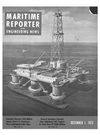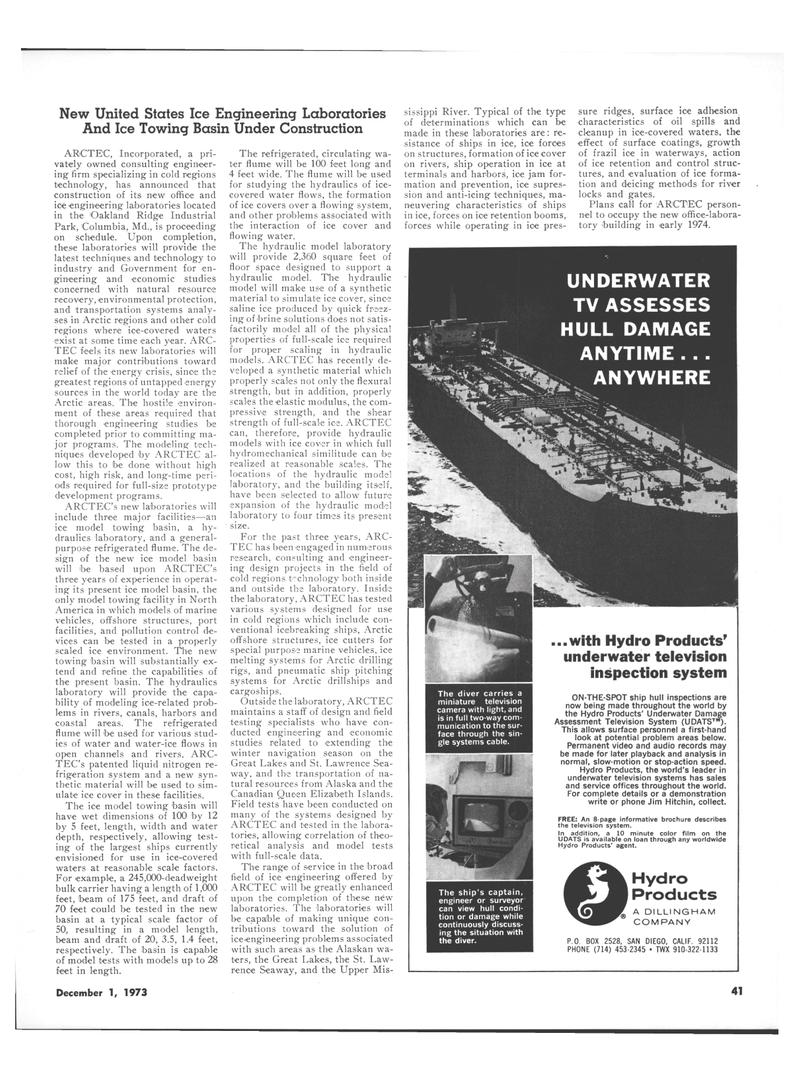
Page 37: of Maritime Reporter Magazine (December 1973)
Read this page in Pdf, Flash or Html5 edition of December 1973 Maritime Reporter Magazine
New United States Ice Engineering Laboratories
And Ice Towing Basin Under Construction
ARCTEC, Incorporated, a pri- vately owned consulting engineer- ing firm specializing in cold regions technology, has announced that construction of its new office and ice engineering laboratories located in the 'Oakland Ridge Industrial
Park, Columbia, Md., is proceeding on schedule. Upon completion, these laboratories will provide the latest techniques and technology to industry and Government for en- gineering and economic studies concerned with natural resource recovery, environmental protection, and transportation systems analy- ses in Arctic regions and other colcl regions where ice-covered waters exist at some time each year. ARC-
TEC feels its new laboratories will make major contributions toward relief of the energy crisis, since the greatest regions of untapped energy sources in the world today are the
Arctic areas. The hostile environ- ment of these areas required that thorough engineering studies be completed prior to committing ma- jor programs. The modeling tech- niques developed by ARCTEC al- low this to be done without high cost, high risk, and long-time peri- ods required for full-size prototype development programs.
AR'CTBCs new laboratories will include three major facilities—an ice model towing basin, a hy- draulics laboratory, and a general- purpose refrigerated flume. The de- sign of the new ice model basin will be based upon ARCTEC's three years of experience in operat- ing its present ice model basin, the only model towing facility in North
America in which models of marine vehicles, offshore structures, port facilities, and pollution control de- vices can be tested in a properly scaled ice environment. The new towing basin will substantially ex- tend and refine the capabilities of the present basin. The hydraulics laboratory will provide the capa- bility of modeling ice-related prob- lems in rivers, canals, harbors and coastal areas. The refrigerated flume will 'be used for various stud- ies of water and water-ice flows in open channels and rivers. ARC-
TEC's patented liquid nitrogen re- frigeration system and a new syn- thetic material will be used to sim- ulate ice cover in these facilities.
The ice model towing basin will have wet dimensions of 100 by 12 by 5 feet, length, width and water depth, respectively, allowing test- ing of the largest ships currently envisioned for use in ice-covered waters at reasonable scale factors.
For example, a 245,000-deadweight bulk carrier having a length of 1,000 feet, 'beam of 175 feet, and draft of 70 feet could be tested in the new basin at a typical scale factor of 50, resulting in a model length, beam and draft of 20, 3.5, 1.4 feet, respectively. The basin is capable of model tests with models up to 28 feet in length.
The refrigerated, circulating wa- ter flume will be 100 feet long and 4 feet wide. The flume will be used for studying the hydraulics of ice- covered water flows, the formation of ice covers over a flowing system, and other problems associated with the interaction of ice cover and flowing water.
The hydraulic model laboratory will provide 2,360 square feet of floor space designed to support a hydraulic model. The hydraulic model will make use of a synthetic material to simulate ice cover, since saline ice produced by quick freez- ing of brine solutions does not satis- factorily model all of the physical properties of full-scale ice required for proper scaling in hydraulic models. ARCTEC has recently de- veloped a synthetic material which properly scales not only the flexural strength, but in addition, properly scales the elastic modulus, the com- pressive strength, and the shear strength of full-scale ice. ARCTEC can, therefore, provide hydraulic models with ice cover in which full hydromechanical similitude can be realized at reasonable scales. The locations of the hydraulic model laboratory, and the building itself, have been selected to allow future expansion of the hydraulic model laboratory to four times its present size.
For the past three years, ARC-
TEC has been engaged in numerous research, consulting and engineer- ing design projects in the field of cold regions t-chnology both inside and outside the laboratory. Inside the laboratory, ARCTEC has tested various systems designed for use in cold regions which include con- ventional icebreaking ships, Arctic offshore structures, ice cutters for special purpose marine vehicles, ice melting systems for Arctic drilling rigs, and pneumatic ship pitching systems for Arctic drillships and cargoships.
Outside the laboratory, ARCTEC maintains a staff of design and field testing specialists who have con- ducted engineering and economic studies related to extending the winter navigation season on the
Great Lakes and St. Lawrence Sea- way, and the transportation of na- tural resources from Alaska and the
Canadian Queen Elizabeth Islands.
Field tests have been conducted on many of the systems designed by
ARCTEC and tested in the labora- tories, allowing correlation of theo- retical analysis and model tests with full-scale data.
The range of service in the broad field of ice engineering offered by
ARCTEC will be greatly enhanced upon the completion of these new laboratories. The laboratories will be capable of making unique con- tributions toward the solution of ice engineering problems associated with such areas as the Alaskan wa- ters, the Great Lakes, the St. Law- rence Seaway, and the Upper Mis- sissippi River. Typical of the type of determinations which can be made in these laboratories are: re- sistance of ships in ice, ice forces on structures, formation of ice cover on rivers, ship operation in ice at terminals and harbors, ice jam for- mation and prevention, ice supres- sion and anti-icing techniques, ma- neuvering characteristics of ships in ice, forces on ice retention booms, forces while operating in ice pres- sure ridges, surface ice adhesion characteristics of oil spills and cleanup in ice-covered waters, the effect of surface coatings, growth of frazil ice in waterways, action of ice retention and control struc- tures, and evaluation of ice forma- tion and deicing methods for river locks and gates.
Plans call for ARCTEC person- nel to occupy the new office-labora- tory building in early 1974.
The diver carries a miniature television camera with light, and is in full two-way com- munication to the sur- face through the sin- gle systems cable.
The ship's captain, engineer or surveyor can view hull condi- tion or damage while continuously discuss- ing the situation with the diver.
UNDERWATER
TV ASSESSES
HULL DAMAGE
ANYTIME . . .
ANYWHERE
ON-THE-SPOT ship hull inspections are now being made throughout the world by the Hydro Products' Underwater Damage
Assessment Television System (UDATS™).
This allows surface personnel a first-hand look at potential problem areas below.
Permanent video and audio records may be made for later playback and analysis in normal, slow-motion or stop-action speed.
Hydro Products, the world's leader in underwater television systems has sales and service offices throughout the world.
For complete details or a demonstration write or phone Jim Hitchin, collect.
FREE: An 8 page informative brochure describes the television system.
In addition, a 10 minute color film on the
UDATS is available on loan through any worldwide
Hydro Products' agent. ©
Hydro
Products
A DILLINGHAM
COM PANY
P.O. BOX 2528, SAN DIEGO, CALIF. 92112
PHONE (714) 453-2345 • TWX 910-322 1133 ...with Hydro Products' underwater television inspection system
December 1, 1973 41

 36
36

 38
38
